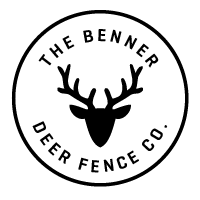How to Chose What Deer Fence Materials to Use
Everything you need to know about determining what materials and tools you need for your DIY deer fencing project
Determine Materials
Use the Charts below to help you decide what type of deer fence, fence height and cable support system are necessary for your situation.
TYPES OF FENCE
We offer a wide selection of fencing materials including: polypropylene, metal, or polypropylene and metal fence blended together. These fences come in a variety of strengths, heights and mesh designs. You can learn more about the different types of fence in our fence shop.
Poly fence can be used on it’s own to keep deer out. However, it can be chewed through by rodents and damaged by lawn maintenance equipment. Stand alone poly fence is a good option for wooded areas with minimal rodent activity.
Poly fence with metal at the bottom is our most versatile option and provides a chew proof barrier along the lower section of the fence. It can accommodate almost any height and is easy to install.
An all metal deer fence works in most applications and comes in a variety of thicknesses.
FENCE HEIGHT
Consider the specific situation when selecting your fence height. For keeping deer out, the larger your enclosure, the higher the fence needs to be. The Benner Deer Fence Co. has been using a 7’ fence as our standard perimeter deer fence height and it has been very effective over the last 15 years. A smaller enclosure, such as a garden fence may only require a 6’ high fence. Deer tend to avoid jumping into areas where they are fearful of being trapped.
HORIZONTAL CABLE SUPPORT SYSTEMS
The larger and higher your fence enclosure, the more horizontal cable supports you need. We recommend using an 8-gauge metal cable for the bottom of the fence. 11-gauge nylon for the middle and an 8-gauge nylon for the top. A fence with no cable supports should only be used for a removable fence system. A single cable support system could be used for an all poly fence in wooded areas with the use of ground stakes to secure the fence at the bottom. A 2-cable system can be used with an all poly or all metal fence, example: a 4-foot high pool fence would only need 2 cables. A poly-metal blended fence requires a 3-cable support system. The middle cable is used to support the top of the metal fence. A 4-cable system is recommended for high traffic areas. The 4th cable can be added in selected areas if the fence line crosses a deer trail.
WHAT MATERIALS DO YOU NEED FOR YOUR PROJECT?
FENCE
Use a measuring tape to measure deer fence line.
For every 100 feet of linear fence an additional 10 feet of fence is needed.
CABLE
For every 200 feet of linear fence an additional 10 feet of each cable (top, middle and bottom) is needed.
POST KITS
Flat ground: one line post kit for every 10–14 feet is needed
Hilly/moderate turns: one line post kit for every 8–12 feet is needed
Hard turns: one corner kit is needed for every turn less than 110 degrees.
End: one end kit is needed everywhere the fence line terminates, either at a building or into another type of fencing.
TREES AS POSTS*
For each tree that is used as a post, 3 eye-lag screws and an additional 15 feet of 8 gauge nylon cable and 1 large gripple is needed. *If a tree must be used as a post, we recommend our trees as post installation method.
GATE KITS
Gate posts are included in gate kit unless otherwise noted or requested.
Gate kits do not include fence to cover gate. You will need to plan for additional fence to cover gate.
GROUND STAKES
One ground stake is recommended any time the distance between posts is greater than 8 feet. We recommend 18 inch rebar ground stakes.
CABLE TIES
Approximately 50, 14-inch heavy duty cable ties are needed for every 100 feet of linear fence.
CABLE GRIPPLES
A cable gripple is needed for every cable termination.
For every 200 feet of fence, two gripples are needed for each run of cable.
We recommend ordering a few extra gripples to have on hand.
OPTIONAL: One u-bolt cable connector can be used at one end of each cable termination. The opposite end needs to terminated with a gripple so that the cable can be tightened.
HOG RING CLIPS
300-400 hog ring clips are needed for every 100 feet of fence. For all metal or metal and poly fence, we recommend using 3/4" hog ring clips. For all poly fence (with or with out a rodent barrier fence), we recommend using 3/4”, 9/16” or 11/16” hog rings.
OPTIONAL MATERIALS
rubber cement for securing posts caps to posts.
Need more help with planning your deer fence project?
Tools
NECESSARY TOOLS FOR DEER FENCING:
Post Driver (Professional System)
Driving Cap (Standard System)
San Angelo digging bar
Dewalt Compound Action Long Nose Pliers
9-inch magnetic level
Hog ring gun
Cordless Power Drill Drive (3/8 inch)
11/64” drill bit
Small sledge hammer (3 lbs)
9/16” wrench or deep socket
½” wrench or deep socket
3/8” magnetic driver
We offer most of these items in the deer fence tool section of our store. These tools can also be found at most hardware stores.
RECOMMENDED TOOLS FOR DEER FENCING:
100 or 250 foot measuring tape
¼” drive socket adapter (for deep socket power tightening of nuts)
5/16” drill bit (used to pilot holes for tree fastening)
10 lbs. sledge hammer (Collins is a good brand)
Post-hole digger (standard size)
Tool belt (one sided, deep pocket)
Cordless Sawzall tool
6” metal cut off Sawzall blade (medium metal teeth)
We offer most of these items in the deer fence tool section of our store. These tools can also be found at most hardware stores.
